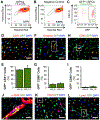Abcg2-expressing side population cells contribute to cardiomyocyte renewal through fusion
- PMID: 32100368
- PMCID: PMC7136149
- DOI: 10.1096/fj.201902105R
Abcg2-expressing side population cells contribute to cardiomyocyte renewal through fusion
Abstract
The adult mammalian heart has a limited regenerative capacity. Therefore, identification of endogenous cells and mechanisms that contribute to cardiac regeneration is essential for the development of targeted therapies. The side population (SP) phenotype has been used to enrich for stem cells throughout the body; however, SP cells isolated from the heart have been studied exclusively in cell culture or after transplantation, limiting our understanding of their function in vivo. We generated a new Abcg2-driven lineage-tracing mouse model with efficient labeling of SP cells. Labeled SP cells give rise to terminally differentiated cells in bone marrow and intestines. In the heart, labeled SP cells give rise to lineage-traced cardiomyocytes under homeostatic conditions with an increase in this contribution following cardiac injury. Instead of differentiating into cardiomyocytes like proposed cardiac progenitor cells, cardiac SP cells fuse with preexisting cardiomyocytes to stimulate cardiomyocyte cell cycle reentry. Our study is the first to show that fusion between cardiomyocytes and non-cardiomyocytes, identified by the SP phenotype, contribute to endogenous cardiac regeneration by triggering cardiomyocyte cell cycle reentry in the adult mammalian heart.
Keywords: cardiac regeneration; cardiomyocyte proliferation; fusion; side population.
© 2020 Federation of American Societies for Experimental Biology.
Figures






Similar articles
-
Gata4-Dependent Differentiation of c-Kit+-Derived Endothelial Cells Underlies Artefactual Cardiomyocyte Regeneration in the Heart.Circulation. 2018 Sep 4;138(10):1012-1024. doi: 10.1161/CIRCULATIONAHA.118.033703. Circulation. 2018. PMID: 29666070 Free PMC article.
-
Abcg2-Labeled Cells Contribute to Different Cell Populations in the Embryonic and Adult Heart.Stem Cells Dev. 2016 Feb 1;25(3):277-84. doi: 10.1089/scd.2015.0272. Epub 2016 Jan 7. Stem Cells Dev. 2016. PMID: 26573225 Free PMC article.
-
Role of the ATP-binding cassette transporter Abcg2 in the phenotype and function of cardiac side population cells.Circ Res. 2008 Oct 10;103(8):825-35. doi: 10.1161/CIRCRESAHA.108.174615. Epub 2008 Sep 11. Circ Res. 2008. PMID: 18787193 Free PMC article.
-
Non-coding RNAs in Cardiac Regeneration.Adv Exp Med Biol. 2020;1229:163-180. doi: 10.1007/978-981-15-1671-9_9. Adv Exp Med Biol. 2020. PMID: 32285411 Review.
-
Cardiomyocyte death and renewal in the normal and diseased heart.Cardiovasc Pathol. 2008 Nov-Dec;17(6):349-74. doi: 10.1016/j.carpath.2008.02.004. Epub 2008 Apr 1. Cardiovasc Pathol. 2008. PMID: 18402842 Review.
Cited by
-
Heart Regeneration by Endogenous Stem Cells and Cardiomyocyte Proliferation: Controversy, Fallacy, and Progress.Circulation. 2020 Jul 21;142(3):275-291. doi: 10.1161/CIRCULATIONAHA.119.045566. Epub 2020 Jul 20. Circulation. 2020. PMID: 32687441 Free PMC article.
-
Cardiac Resident Macrophages Prevent Fibrosis and Stimulate Angiogenesis.Circ Res. 2021 Dec 3;129(12):1086-1101. doi: 10.1161/CIRCRESAHA.121.319737. Epub 2021 Oct 14. Circ Res. 2021. PMID: 34645281 Free PMC article.
-
Inducible cardiomyocyte injury within the atrioventricular conduction system uncovers latent regenerative capacity in mice.J Clin Invest. 2021 Oct 1;131(19):e138637. doi: 10.1172/JCI138637. J Clin Invest. 2021. PMID: 34596051 Free PMC article.
-
Cardiac stem cells: Current knowledge and future prospects.World J Stem Cells. 2022 Jan 26;14(1):1-40. doi: 10.4252/wjsc.v14.i1.1. World J Stem Cells. 2022. PMID: 35126826 Free PMC article. Review.
-
Electrophysiological Properties of Tetraploid Cardiomyocytes Derived from Murine Pluripotent Stem Cells Generated by Fusion of Adult Somatic Cells with Embryonic Stem Cells.Int J Mol Sci. 2023 Mar 31;24(7):6546. doi: 10.3390/ijms24076546. Int J Mol Sci. 2023. PMID: 37047520 Free PMC article.
References
Publication types
MeSH terms
Substances
Grants and funding
LinkOut - more resources
Full Text Sources
Molecular Biology Databases

